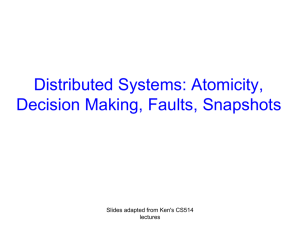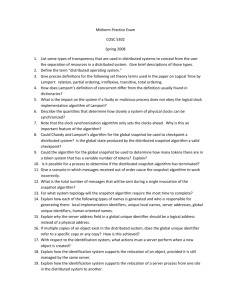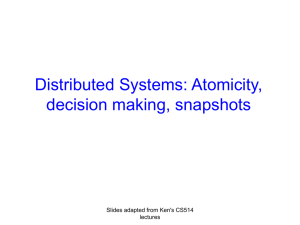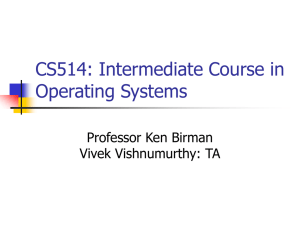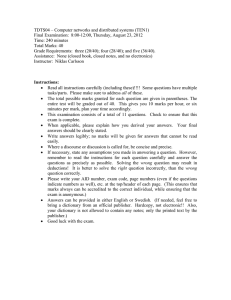Distributed Systems Overview Slides adapted from Ken's CS514 lectures
advertisement
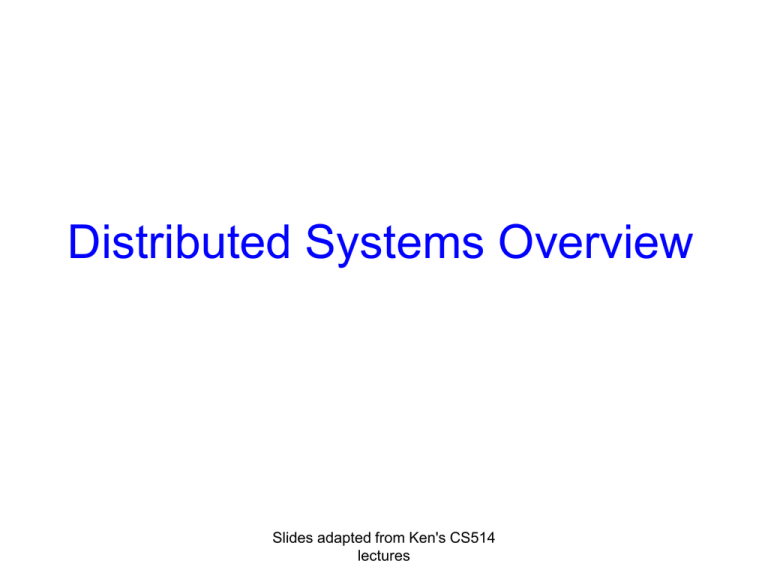
Distributed Systems Overview
Slides adapted from Ken's CS514
lectures
Distributed Systems
Definition:
Loosely coupled processors interconnected by network
• Distributed system is a piece of software that ensures:
– Independent computers appear as a single coherent system
• Lamport: “A distributed system is a system where I can’t
get my work done because a computer has failed that I
never heard of”
2
Distributed Systems Goals
•
•
•
•
Connecting resources and users
Distributed transparency: migration, location, failure, …
Openness: portability, interoperability
Scalability: size, geography, administrative
Machine A
Machine B
Machine C
Distributed Applications
Middleware
Local OS
Local OS
Local OS
3
Network
Today
• What is the time now?
• What does the entire system look like at this moment?
• Faults in distributed systems
4
What time is it?
In distributed system we need practical
ways to deal with time
E.g. we may need to agree that update A
occurred before update B
Or offer a “lease” on a resource that
expires at time 10:10.0150
Or guarantee that a time critical event will
reach all interested parties within 100ms
5
But what does time “mean”?
Time on a global clock?
… or on a machine’s local clock
E.g. with GPS receiver
But was it set accurately?
And could it drift, e.g. run fast or slow?
What about faults, like stuck bits?
… or could try to agree on time
6
Lamport’s approach
Leslie Lamport suggested that we
should reduce time to its basics
Time lets a system ask “Which came first:
event A or event B?”
In effect: time is a means of labeling
events so that…
If A happened before B, TIME(A) < TIME(B)
If TIME(A) < TIME(B), A happened before B
7
Drawing time-line pictures:
p
sndp(m)
m
D
q
rcvq(m)
delivq(m)
8
Drawing time-line pictures:
p
sndp(m)
A
B
m
q
D
C
rcvq(m)
A, B, C and D are “events”.
delivq(m)
Could be anything meaningful to the application
So are snd(m) and rcv(m) and deliv(m)
What ordering claims are meaningful?
9
Drawing time-line pictures:
p
sndp(m)
A
B
m
q
D
C
rcvq(m)
delivq(m)
A happens before B, and C before D
“Local ordering” at a single process
Write A B and C D
p
q
10
Drawing time-line pictures:
p
sndp(m)
A
B
m
q
D
C
rcvq(m)
delivq(m)
sndp(m) also happens before rcvq(m)
“Distributed ordering” introduced by a message
Write snd ( m ) rcv ( m )
M
p
q
11
Drawing time-line pictures:
p
sndp(m)
A
B
m
q
D
C
rcvq(m)
delivq(m)
A happens before D
Transitivity: A happens before sndp(m), which
happens before rcvq(m), which happens before D
12
Drawing time-line pictures:
p
sndp(m)
A
B
m
q
D
C
rcvq(m)
delivq(m)
B and D are concurrent
Looks like B happens first, but D has no
way to know. No information flowed…
13
Happens before “relation”
We’ll say that “A happens before B”,
written AB, if
1.
2.
3.
APB according to the local ordering, or
A is a snd and B is a rcv and AMB, or
A and B are related under the transitive
closure of rules (1) and (2)
So far, this is just a mathematical
notation, not a “systems tool”
14
Logical clocks
A simple tool that can capture parts of
the happens before relation
First version: uses just a single integer
Designed for big (64-bit or more) counters
Each process p maintains LTp, a local
counter
A message m will carry LTm
15
Rules for managing logical clocks
When an event happens at a process p it
increments LTp.
When p sends m, set
Any event that matters to p
Normally, also snd and rcv events (since we want
receive to occur “after” the matching send)
LTm = LTp
When q receives m, set
LTq = max(LTq, LTm)+1
16
Time-line with LT annotations
sndp(m)
p
LTp
A
0
1
B
1
2
2
2
2
2
2
3
3
3
3
m
q
C
rcvq(m)
LTq
0
0
0
1
1
1
1
3
3
D
delivq(m)
3
4
5
5
LT(A) = 1, LT(sndp(m)) = 2, LT(m) = 2
LT(rcvq(m))=max(1,2)+1=3, etc…
17
Logical clocks
If A happens before B, AB,
then LT(A)<LT(B)
But converse might not be true:
If LT(A)<LT(B) can’t be sure that AB
This is because processes that don’t
communicate still assign timestamps and
hence events will “seem” to have an order
18
Introducing “wall clock time”
There are several options
“Extend” a logical clock with the clock time
and use it to break ties
Makes meaningful statements like “B and D
were concurrent, although B occurred first”
But unless clocks are closely synchronized such
statements could be erroneous!
We use a clock synchronization algorithm
to reconcile differences between clocks on
various computers in the network
19
Synchronizing clocks
Without help, clocks will often differ by
many milliseconds
Problem is that when a machine downloads
time from a network clock it can’t be sure
what the delay was
This is because the “uplink” and “downlink”
delays are often very different in a network
Outright failures of clocks are rare…
20
Synchronizing clocks
Delay: 123ms
p
What time is it?
09:23.02921
time.windows.com
Suppose p synchronizes with time.windows.com and notes that 123 ms
elapsed while the protocol was running… what time is it now?
21
Synchronizing clocks
Options?
P could guess that the delay was evenly split, but
this is rarely the case in WAN settings (downlink
speeds are higher)
P could ignore the delay
P could factor in only “certain” delay, e.g. if we
know that the link takes at least 5ms in each
direction. Works best with GPS time sources!
In general can’t do better than uncertainty in
the link delay from the time source down to p
22
Consequences?
In a network of processes, we must
assume that clocks are
Not perfectly synchronized. Even GPS has
uncertainty, although small
We say that clocks are “inaccurate”
And clocks can drift during periods
between synchronizations
Relative drift between clocks is their “precision”
23
Temporal distortions
Things can be complicated because we
can’t predict
Message delays (they vary constantly)
Execution speeds (often a process shares a
machine with many other tasks)
Timing of external events
Lamport looked at this question too
24
Temporal distortions
p0
p1
p2
What does “now” mean?
a
d
b
c
e
f
p3
25
Temporal distortions
p0
p1
p2
What does “now” mean?
a
d
b
c
e
f
p3
26
Temporal distortions
p0
Timelines can “stretch”…
a
d
b
p1
c
e
f
p2
p3
… caused by scheduling effects,
message delays, message loss…
27
Temporal distortions
p0
Timelines can “shrink”
a
d
b
p1
c
e
f
p2
p3
E.g. something lets a machine speed up
28
Temporal distortions
p0
Cuts represent instants of time.
a
d
b
p1
c
e
f
p2
p3
But not every “cut” makes sense
Black cuts could occur but not gray ones.
29
Consistent cuts and snapshots
Idea is to identify system states that
“might” have occurred in real-life
Need to avoid capturing states in which a
message is received but nobody is shown
as having sent it
This the problem with the gray cuts
30
Temporal distortions
p0
p1
p2
Red messages cross gray cuts “backwards”
a
d
b
c
e
f
p3
31
Temporal distortions
p0
Red messages cross gray cuts “backwards”
a
b
p1
c
e
p2
p3
In a nutshell: the cut includes a
message that “was never sent”
32
Who cares?
Suppose, for example, that we want to
do distributed deadlock detection
System lets processes “wait” for actions by
other processes
A process can only do one thing at a time
A deadlock occurs if there is a circular wait
33
Deadlock detection “algorithm”
p worries: perhaps we have a deadlock
p is waiting for q, so sends “what’s your
state?”
q, on receipt, is waiting for r, so sends
the same question… and r for s…. And s
is waiting on p.
34
Suppose we detect this state
We see a cycle…
p
Waiting for
Waiting for
Waiting for
s
q
Waiting for
r
… but is it a deadlock?
35
Phantom deadlocks!
Suppose system has a very high rate of
locking.
Then perhaps a lock release message
“passed” a query message
i.e. we see “q waiting for r” and “r waiting for s”
but in fact, by the time we checked r, q was no
longer waiting!
In effect: we checked for deadlock on a gray
cut – an inconsistent cut.
36
Consistent cuts and snapshots
Goal is to draw a line across the system
state such that
Every message “received” by a process is
shown as having been sent by some other
process
Some pending messages might still be in
communication channels
A “cut” is the frontier of a “snapshot”
37
Chandy/Lamport Algorithm
Assume that if pi can talk to pj they do so
using a lossless, FIFO connection
Now think about logical clocks
Suppose someone sets his clock way ahead and
triggers a “flood” of messages
As these reach each process, it advances its own
time… eventually all do so.
The point where time jumps forward is a
consistent cut across the system
38
Using logical clocks to make cuts
Message sets the time
forward by a “lot”
p0
p1
p2
a
d
b
c
e
f
p3
Algorithm requires FIFO channels: must
delay e until b has been delivered!
39
Using logical clocks to make cuts
“Cut” occurs at point
where time advanced
p0
p1
p2
a
d
b
c
e
f
p3
40
Turn idea into an algorithm
To start a new snapshot, pi …
Builds a message: “Pi is initiating snapshot k”.
In general, on first learning about snapshot (pi, k), px
The tuple (pi, k) uniquely identifies the snapshot
Writes down its state: px’s contribution to the snapshot
Starts “tape recorders” for all communication channels
Forwards the message on all outgoing channels
Stops “tape recorder” for a channel when a snapshot
message for (pi, k) is received on it
Snapshot consists of all the local state contributions
and all the tape-recordings for the channels
41
Chandy/Lamport
This algorithm, but implemented with
an outgoing flood, followed by an
incoming wave of snapshot
contributions
Snapshot ends up accumulating at the
initiator, pi
Algorithm doesn’t tolerate process
failures or message failures.
42
Chandy/Lamport
w
q
t
r
p
s
u
y
v
x
z
A network
43
Chandy/Lamport
w
I want to start
a snapshot
q
t
r
p
s
u
y
v
x
z
A network
44
Chandy/Lamport
w
q
p records local state
t
r
p
s
u
y
v
x
z
A network
45
Chandy/Lamport
w
p starts monitoring
incoming channels
q
t
r
p
s
u
y
v
x
z
A network
46
Chandy/Lamport
w
“contents of channel py”
q
t
r
p
s
u
y
v
x
z
A network
47
Chandy/Lamport
w
p floods message on
outgoing channels…
q
t
r
p
s
u
y
v
x
z
A network
48
Chandy/Lamport
w
q
t
r
p
s
u
y
v
x
z
A network
49
Chandy/Lamport
w
q is done
q
t
r
p
s
u
y
v
x
z
A network
50
Chandy/Lamport
w
q
q
t
r
p
s
u
y
v
x
z
A network
51
Chandy/Lamport
w
q
q
t
r
p
s
u
y
v
x
z
A network
52
Chandy/Lamport
w
q
q
t
r
p
s
u
y
v
s
x
z
z
A network
53
Chandy/Lamport
w
q
q
p
s
t
x
r
u
u
y
s
v
x
z
z
v
A network
54
Chandy/Lamport
w
w
x
q
q
s
z
y
v
u
r
t
r
p
s
u
y
v
x
z
A network
55
Chandy/Lamport
w
p
q
r
s
t
u
v
w
x
y
Done!
q
t
r
p
s
u
y
v
x
z
z
A snapshot of a network
56
What’s in the “state”?
In practice we only record things important to
the application running the algorithm, not the
“whole” state
E.g. “locks currently held”, “lock release
messages”
Idea is that the snapshot will be
Easy to analyze, letting us build a picture of the
system state
And will have everything that matters for our real
purpose, like deadlock detection
57
Categories of failures
Crash faults, message loss
These are common in real systems
Crash failures: process simply stops, and
does nothing wrong that would be
externally visible before it stops
These faults can’t be directly detected
58
Categories of failures
Fail-stop failures
These require system support
Idea is that the process fails by crashing,
and the system notifies anyone who was
talking to it
With fail-stop failures we can overcome
message loss by just resending packets,
which must be uniquely numbered
Easy to work with… but rarely supported
59
Categories of failures
Non-malicious Byzantine failures
This is the best way to understand many
kinds of corruption and buggy behaviors
Program can do pretty much anything,
including sending corrupted messages
But it doesn’t do so with the intention of
screwing up our protocols
Unfortunately, a pretty common mode
of failure
60
Categories of failure
Malicious, true Byzantine, failures
Model is of an attacker who has studied the
system and wants to break it
She can corrupt or replay messages, intercept
them at will, compromise programs and substitute
hacked versions
This is a worst-case scenario mindset
In practice, doesn’t actually happen
Very costly to defend against; typically used in
very limited ways (e.g. key mgt. server)
61
Models of failure
Question here concerns how failures
appear in formal models used when
proving things about protocols
Think back to Lamport’s happens-before
relationship,
Model already has processes, messages,
temporal ordering
Assumes messages are reliably delivered
62
Recall: Two kinds of models
We tend to work within two models
Asynchronous model makes no
assumptions about time
Lamport’s model is a good fit
Processes have no clocks, will wait indefinitely
for messages, could run arbitrarily fast/slow
Distributed computing at an “eons” timescale
Synchronous model assumes a lock-step
execution in which processes share a clock
63
Adding failures in Lamport’s model
Also called the asynchronous model
Normally we just assume that a failed process
“crashes:” it stops doing anything
Notice that in this model, a failed process is
indistinguishable from a delayed process
In fact, the decision that something has failed
takes on an arbitrary flavor
Suppose that at point e in its execution, process p
decides to treat q as faulty….”
64
What about the synchronous model?
Here, we also have processes and messages
But communication is usually assumed to be
reliable: any message sent at time t is delivered
by time t+
Algorithms are often structured into rounds, each
lasting some fixed amount of time , giving time
for each process to communicate with every other
process
In this model, a crash failure is easily detected
When people have considered malicious
failures, they often used this model
65
Neither model is realistic
Value of the asynchronous model is that it is
so stripped down and simple
If we can do something “well” in this model we
can do at least as well in the real world
So we’ll want “best” solutions
Value of the synchronous model is that it
adds a lot of “unrealistic” mechanism
If we can’t solve a problem with all this help, we
probably can’t solve it in a more realistic setting!
So seek impossibility results
66
Fischer, Lynch and Patterson
A surprising result
Impossibility of Asynchronous Distributed
Consensus with a Single Faulty Process
They prove that no asynchronous algorithm
for agreeing on a one-bit value can guarantee
that it will terminate in the presence of crash
faults
And this is true even if no crash actually occurs!
Proof constructs infinite non-terminating runs
67
Tougher failure models
We’ve focused on crash failures
In the synchronous model these look like a
“farewell cruel world” message
Some call it the “failstop model”. A faulty process
is viewed as first saying goodbye, then crashing
What about tougher kinds of failures?
Corrupted messages
Processes that don’t follow the algorithm
Malicious processes out to cause havoc?
68
Here the situation is much harder
Generally we need at least 3f+1
processes in a system to tolerate f
Byzantine failures
For example, to tolerate 1 failure we need
4 or more processes
We also need f+1 “rounds”
Let’s see why this happens
69
Byzantine scenario
Generals (N of them) surround a city
Each has an opinion: “attack” or “wait”
They communicate by courier
In fact, an attack would succeed: the city will fall.
Waiting will succeed too: the city will surrender.
But if some attack and some wait, disaster ensues
Some Generals (f of them) are traitors… it
doesn’t matter if they attack or wait, but we
must prevent them from disrupting the battle
Traitor can’t forge messages from other Generals
70
Byzantine scenario
Attack!
No, wait!
Surrender!
Wait…
Attack!
Attack!
Wait…
71
A timeline perspective
p
q
r
s
t
Suppose that p and q favor attack, r is a
traitor and s and t favor waiting…
assume that in a tie vote, we attack
72
A timeline perspective
p
q
r
s
t
After first round collected votes are:
{attack, attack, wait, wait, traitor’s-vote}
73
What can the traitor do?
Add a legitimate vote of “attack”
Add a legitimate vote of “wait”
Anyone with 3 votes to attack knows the
outcome
Vote now favors “wait”
Or send different votes to different folks
Or don’t send a vote, at all, to some
74
Outcomes?
Traitor simply votes:
Traitor double-votes
Some see {a,a,a,w,w} and some {a,a,w,w,w}
Traitor withholds some vote(s)
Either all see {a,a,a,w,w}
Or all see {a,a,w,w,w}
Some see {a,a,w,w}, perhaps others see
{a,a,a,w,w,} and still others see {a,a,w,w,w}
Notice that traitor can’t manipulate votes of
loyal Generals!
75
What can we do?
Clearly we can’t decide yet; some loyal
Generals might have contradictory data
In fact if anyone has 3 votes to attack, they can
already “decide”.
Similarly, anyone with just 4 votes can decide
But with 3 votes to “wait” a General isn’t sure
(one could be a traitor…)
So: in round 2, each sends out “witness”
messages: here’s what I saw in round 1
General Smith send me: “attack(signed) Smith”
76
Digital signatures
These require a cryptographic system
For example, RSA
Each player has a secret (private) key K-1
and a public key K.
She can publish her public key
RSA gives us a single “encrypt” function:
Encrypt(Encrypt(M,K),K-1) =
Encrypt(Encrypt(M,K-1),K) = M
Encrypt a hash of the message to “sign” it
77
With such a system
A can send a message to B that only A could
have sent
… or one that only B can read
A encrypts it with B’s public key
Or can sign it as proof she sent it
A just encrypts the body with her private key
B can recompute the signature and decrypt A’s
hashed signature to see if they match
These capabilities limit what our traitor can
do: he can’t forge or modify a message
78
A timeline perspective
p
q
r
s
t
In second round if the traitor didn’t
behave identically for all Generals, we
can weed out his faulty votes
79
A timeline perspective
Attack!!
p
Attack!!
q
Damn! They’re on to me
r
Attack!!
s
Attack!!
t
We attack!
80
Traitor is stymied
Our loyal generals can deduce that the
decision was to attack
Traitor can’t disrupt this…
Either forced to vote legitimately, or is caught
But costs were steep!
(f+1)*n2 ,messages!
Rounds can also be slow….
“Early stopping” protocols: min(t+2, f+1) rounds;
t is true number of faults
81
Other follow-up problems
LC(A) < LC(B) does not imply A B
How to elect a unique leader?
Ensure atomic operations
Deadlock detection
82
